Evaluating the Scale and Potential of GLOF in the Bhutan Himalayas Using a Satellite-Based Integral Glacier–Glacial Lake Inventory
Abstract
:1. Introduction
2. Study Site
3. Data and Methods
3.1. Subsection Completion of Glacier and Glacial Lake Inventory
3.2. Multiple Criteria for Scale and Potential
4. Results
4.1. Current Area and Other Basic Statistics
4.2. Glacier–Glacial Lake Connections and Recent Expansion
4.3. Potential Flood Volumes
5. Discussion
5.1. Current Status of Glacial Lakes
5.2. Interaction and Integration of GLOF Scale Multiple Indices
5.3. Synthesis of Multiple Criteria
6. Conclusions
Acknowledgments
Author Contributions
Conflicts of Interest
References
- Zhang, G.; Yao, T.; Xie, H.; Wang, W.; Yang, W. An inventory of glacial lakes in the Third Pole region and their changes in response to global warming. Glob. Planet. Chang. 2015, 131, 148–157. [Google Scholar] [CrossRef]
- Nie, Y.; Sheng, Y.; Liu, Q.; Liu, L.; Liu, S.; Zhang, Y.; Song, C. A regional-scale assessment of Himalayan glacial lake changes using satellite observations from 1990 to 2015. Remote Sens. Environ. 2017, 189, 1–13. [Google Scholar] [CrossRef]
- Gardelle, J.; Arnaud, Y.; Berthier, E. Contrasted evolution of glacial lakes along the Hindu Kush Himalaya mountain range between 1990 and 2009. Glob. Planet. Chang. 2011, 75, 47–55. [Google Scholar] [CrossRef] [Green Version]
- Ageta, Y.; Iwata, S.; Yabuki, H.; Naito, N.; Sakai, A.; Narama, C. KARMA Expansion of glacier lakes in recent decades in the Bhutan Himalayas. In Debris-Covered Glaciers; Fountain, A., Nakao, M., Raymond, C.F., Eds.; IAHS Publication: Seattle, Washington, DC, USA, 2000; pp. 165–175. [Google Scholar]
- Komori, J. Recent expansions of glacial lakes in the Bhutan Himalayas. Quat. Int. 2008, 184, 177–186. [Google Scholar] [CrossRef]
- Yamada, T. Glacier Lake and Its Outburst Flood in the Nepal Himalaya; Japanese Society of Snow and Ice: Tokyo, Japan, 1998. [Google Scholar]
- Vuichard, D.; Zimmermann, M. The 1985 Catastrophic Drainage of a Moraine-Dammed Lake, Khumbu Himal, Nepal: Cause and Consequences. Mt. Res. Dev. 1987, 7, 91–110. [Google Scholar] [CrossRef]
- Richardson, S.D.; Reynolds, J.M. An overview of glacial hazards in the Himalayas. Quat. Int. 2000, 65–66, 31–47. [Google Scholar] [CrossRef]
- Buchroithner, M.F. Jökulhlaup mapping in the Himalaya by means of remote sensing. Kartogr. Bausteine 1996, 12, 75–86. [Google Scholar]
- Mool, P.K.; Wangda, D.; Bajracharya, S.R.; Kunzang, K.; Grung, D.R.; Joshi, S.P. Inventory of Glaciers, Glacial Lakes and Glacial Lake Outburst Floods. Monitoring and Early Warning Systems in the Hindu Kush-Himalayan Region: Bhutan; ICIMOD: Kathmandu, Nepal, 2001. [Google Scholar]
- Buchroithner, M.F.; Bolch, T. Glacier Lake Outburst Floods (GLOFs)—Mapping the Hazard of a Threat to High Asia and Beyond; Grover, V.I., Borsdorf, A., Breuste, J., Tiwari, P.C., Frangetto, F.W., Eds.; CRC Press: Boca Raton, FL, USA, 2014; ISBN 978-1-4822-0890-0. [Google Scholar]
- Emmer, A.; Vilímek, V. Review Article: Lake and breach hazard moraine-dammed lakes: An example from the Cordillera Blanca (Peru). Nat. Hazards Earth Syst. Sci. 2013, 13, 1551–1565. [Google Scholar] [CrossRef]
- Emmer, A.; Cochachin, A. The causes and mechanisms of moraine-dammed lake failures in the Cordillera Blanca, North American Cordillera, and Himalayas. AUC Geogr. 2013, 48, 5–15. [Google Scholar] [CrossRef]
- Fujita, K.; Sakai, A.; Takenaka, S.; Nuimura, T.; Surazakov, A.B.; Sawagaki, T.; Yamanokuchi, T. Potential flood volume of Himalayan glacial lakes. Nat. Hazards Earth Syst. Sci. 2013, 13, 1827–1839. [Google Scholar] [CrossRef]
- Nagai, H.; Fujita, K.; Nuimura, T.; Sakai, A. Southwest-facing slopes control the formation of debris-covered glaciers in the Bhutan Himalaya. Cryosphere 2013, 7, 1303–1314. [Google Scholar] [CrossRef]
- Nagai, H.; Fujita, K.; Sakai, A.; Nuimura, T.; Tadono, T. Comparison of multiple glacier inventories with a new inventory derived from high-resolution ALOS imagery in the Bhutan Himalaya. Cryosphere 2016, 10, 65–85. [Google Scholar] [CrossRef]
- Tadono, T.; Nagai, H.; Ishida, H.; Oda, F.; Naito, S.; Minakawa, K.; Iwamoto, H. Generation of the 30 m-mesh global digital surface model by ALOS PRISM. Int. Arch. Photogramm. Remote Sens. Spat. Inf. Sci. XXIII ISPRS Congr. 2016, XLI-B4, 157–162. [Google Scholar] [CrossRef]
- Bajracharya, S.R.; Maharjan, S.B.; Shrestha, F. The status and decadal change of glaciers in Bhutan from the 1980s to 2010 based on satellite data. Ann. Glaciol. 2014, 55, 159–166. [Google Scholar] [CrossRef]
- Ageta, Y.; Higuchi, K. Estimation of mass balance components of a summer-accumulation type glacier in the Nepal Himalaya. Geogr. Ann. Ser. A Phys. Geogr. 1984, 66, 249–255. [Google Scholar] [CrossRef]
- Tshering, P.; Fujita, K. First in situ record of decadal glacier mass balance (2003–2014) from the Bhutan Himalaya. Ann. Glaciol. 2016, 57, 289–294. [Google Scholar] [CrossRef]
- Ukita, J.; Narama, C.; Tadono, T.; Yamanokuchi, T.; Tomiyama, N.; Kawamoto, S.; Abe, C.; Uda, T.; Yabuki, H.; Fujita, K.; et al. Glacial lake inventory of Bhutan using ALOS data: Part I. Methods and preliminary results. Ann. Glaciol. 2011, 52, 65–71. [Google Scholar] [CrossRef]
- Fujita, K.; Nishimura, K.; Komori, J.; Iwata, S.; Ukita, J.; Tadono, T.; Koike, T. Outline of Research Project on Glacial Lake Outburst Floods in the Bhutan Himalayas. Glob. Environ. Res. 2012, 16, 3–12. [Google Scholar]
- Tadono, T.; Kawamoto, S.; Narama, C.; Yamanokuchi, T.; Ukita, J.; Tomiyama, N.; Tabuki, H. Development and Validation of New Glacial Lake Inventory in the Bhutan Himalayas Using ALOS “DAICHI”. Glob. Environ. Res. 2012, 16, 31–40. [Google Scholar]
- Veettil, B.K.; Bianchini, N.; de Andrade, A.M.; Bremer, U.F.; Simões, J.C.; de Souza Junior, E. Glacier changes and related glacial lake expansion in the Bhutan Himalaya, 1990–2010. Reg. Environ. Chang. 2015, 16, 1267–1278. [Google Scholar] [CrossRef]
- Salerno, F.; Thakuri, S.; D’Agata, C.; Smiraglia, C.; Manfredi, E.C.; Viviano, G.; Tartari, G. Glacial lake distribution in the Mount Everest region: Uncertainty of measurement and conditions of formation. Glob. Planet. Chang. 2012, 92–93, 30–39. [Google Scholar] [CrossRef]
- Nakao, M.; Young, G.J. Field experiments to determine the effect of a debris layer on ablation of glacier ice. Ann. Glaciol. 1981, 2, 85–91. [Google Scholar] [CrossRef]
- Östrem, G. Ice Melting under a Thin Layer of Moraine, and the Existence of Ice Cores in Moraine Ridges. Geogr. Ann. 1959, 41, 228–230. [Google Scholar]
- Nuimura, T.; Fujita, K.; Yamaguchi, S.; Sharma, R.R. Elevation changes of glaciers revealed by multitemporal digital elevation models calibrated by GPS survey in the Khumbu region, Nepal Himalaya, 1992–2008. J. Glaciol. 2012, 58, 648–656. [Google Scholar] [CrossRef]
- Dwivedi, S.S.K.; Acharya, M.D.M.; Simard, R. The Tam Pokhari glacier lake outburst flood of 3 September 1998. J. Nepal Geol. Soc. 2000, 22, 539–546. [Google Scholar]
- Fujita, K.; Suzuki, R.; Nuimura, T.; Sakai, A. Performance of ASTER and SRTM DEMs, and their potential for assessing glacial lakes in the Lunana region, Bhutan Himalaya. J. Glaciol. 2008, 54, 220–228. [Google Scholar] [CrossRef]
- Meenawat, H.; Sovacool, B.K. Improving adaptive capacity and resilience in Bhutan. Mitig. Adapt. Strateg. Glob. Chang. 2011, 16, 515–533. [Google Scholar] [CrossRef]
- UNDP. Reducing Climate Change-induced Risks and Vulnerabilities from Glacial Lake Outburst Floods in the Punakha-Wangdi and Chamkhar Valleys. In UNDP Project Document Government Bhutan; United Nations Development Program: New York, NY, USA, 2012. [Google Scholar]
- Brauner, M.; Leber, D.; Hausler, H. Glacier Lake Outburst Flood (GLOF) Mitigation Project, Lunana, Bhutan: Technical Mitigation Measures Thorthomi Outlet; Department of Geological Sciences, University of Vienna: Vienna, Austria, 2003; p. 27. [Google Scholar]
- Wang, X.; Liu, S.; Ding, Y.; Guo, W.; Jiang, Z.; Lin, J.; Han, Y. An approach for estimating the breach probabilities of moraine-dammed lakes in the Chinese Himalayas using remote-sensing data. Nat. Hazards Earth Syst. Sci. 2012, 12, 3109–3122. [Google Scholar] [CrossRef] [Green Version]
- Worni, R.; Huggel, C.; Stoffel, M. Science of the Total Environment Glacial lakes in the Indian Himalayas—From an area-wide glacial lake inventory to on-site and modeling based risk assessment of critical glacial lakes. Sci. Total Environ. 2013, 468, S71–S84. [Google Scholar] [CrossRef] [PubMed]
- Rounce, D.R.; McKinney, D.C.; Lala, J.M.; Byers, A.C.; Watson, C.S. A new remote hazard and risk assessment framework for glacial lakes in the Nepal Himalaya. Hydrol. Earth Syst. Sci. 2016, 20, 3455–3475. [Google Scholar] [CrossRef]
- Baťka, J. Factors of formation and development of supraglacial lakes and their quantification: A review. AUC Geogr. 2016, 51, 205–216. [Google Scholar] [CrossRef]
- Kääb, A. Combination of SRTM3 and repeat ASTER data for deriving alpine glacier flow velocities in the Bhutan Himalaya. Remote Sens. Environ. 2005, 94, 463–474. [Google Scholar] [CrossRef]
- Scherler, D.; Bookhagen, B.; Strecker, M.R. Hillslope-glacier coupling: The interplay of topography and glacial dynamics in High Asia. J. Geophys. Res. 2011, 116, F02019. [Google Scholar] [CrossRef]
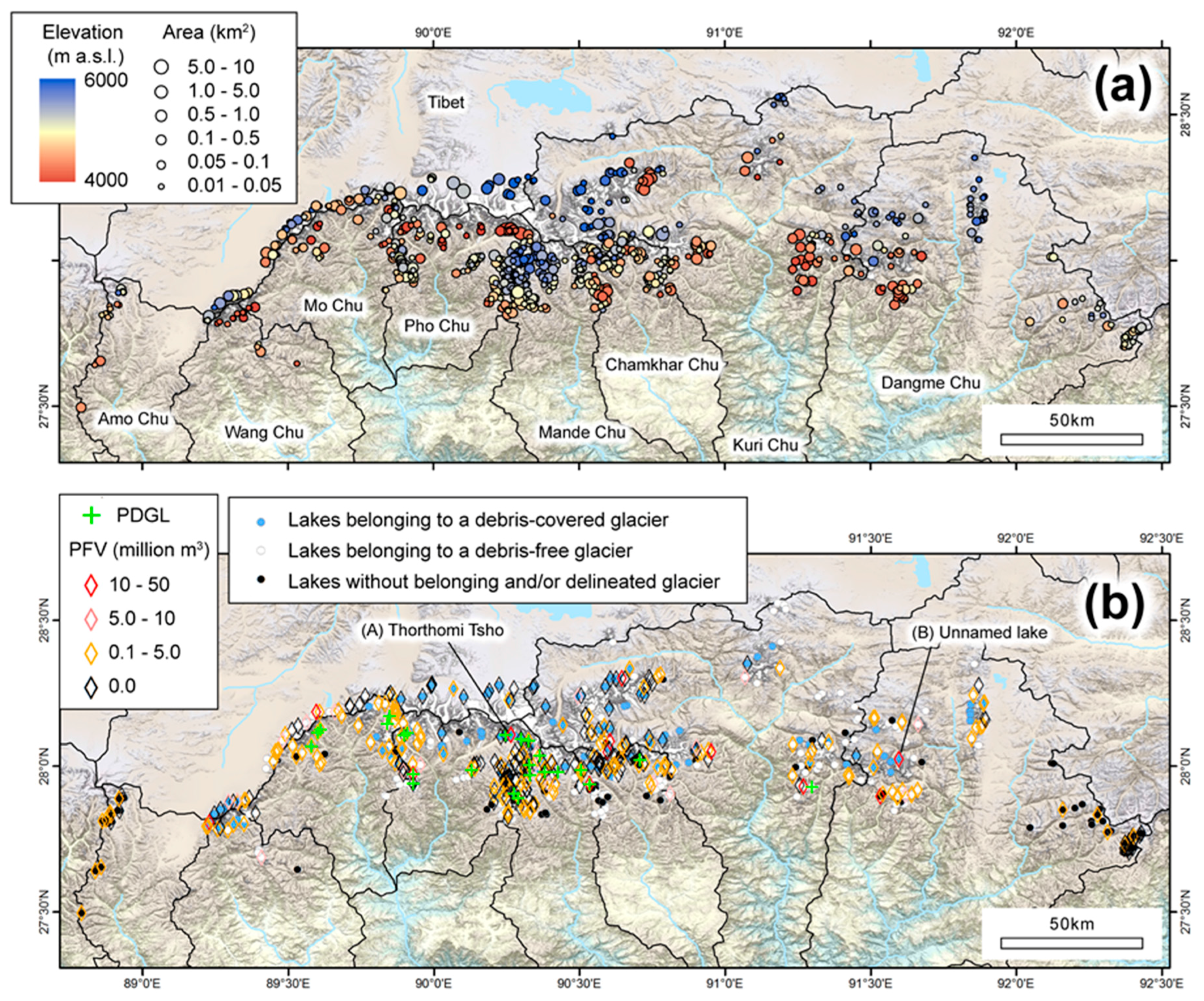
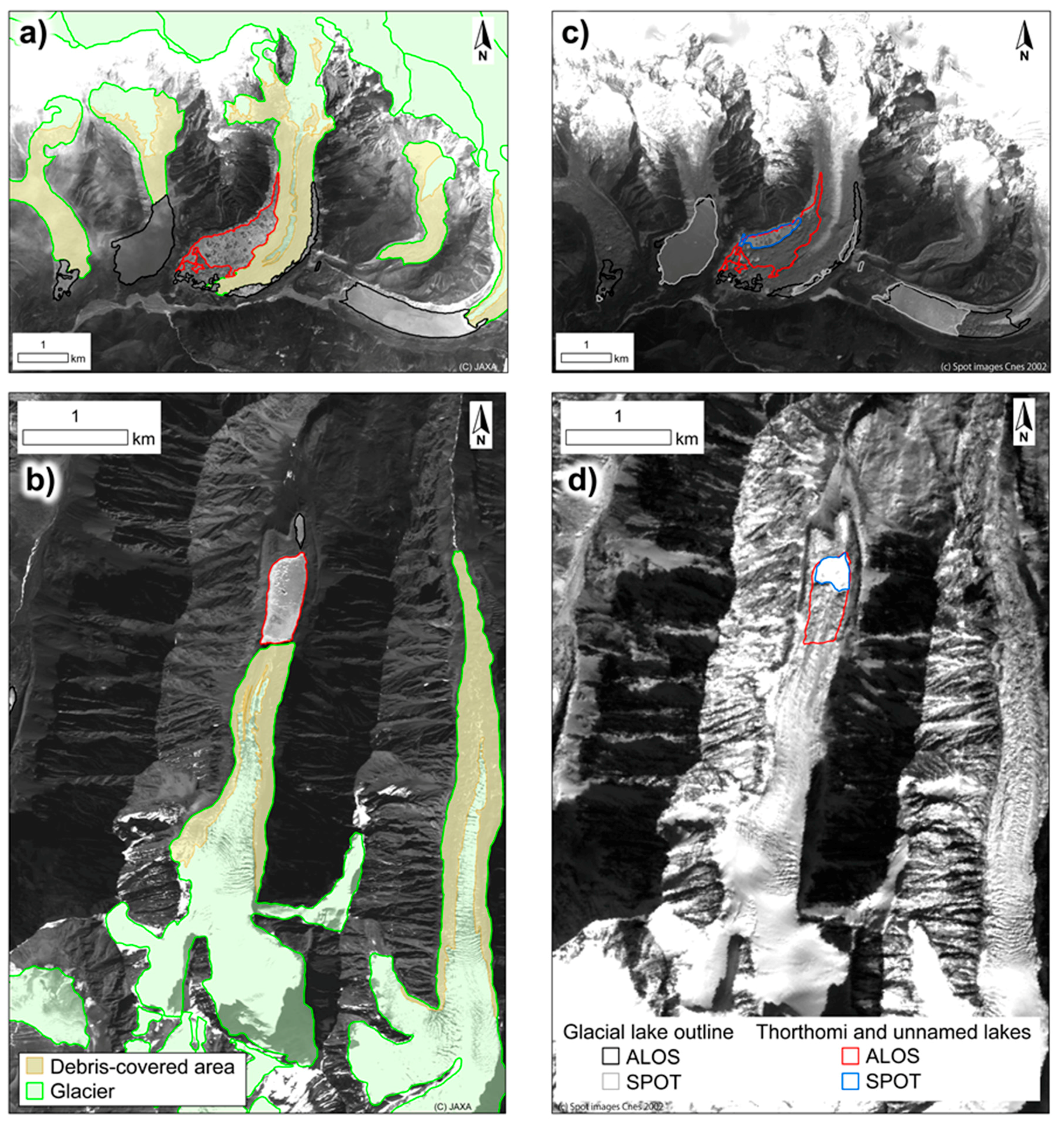
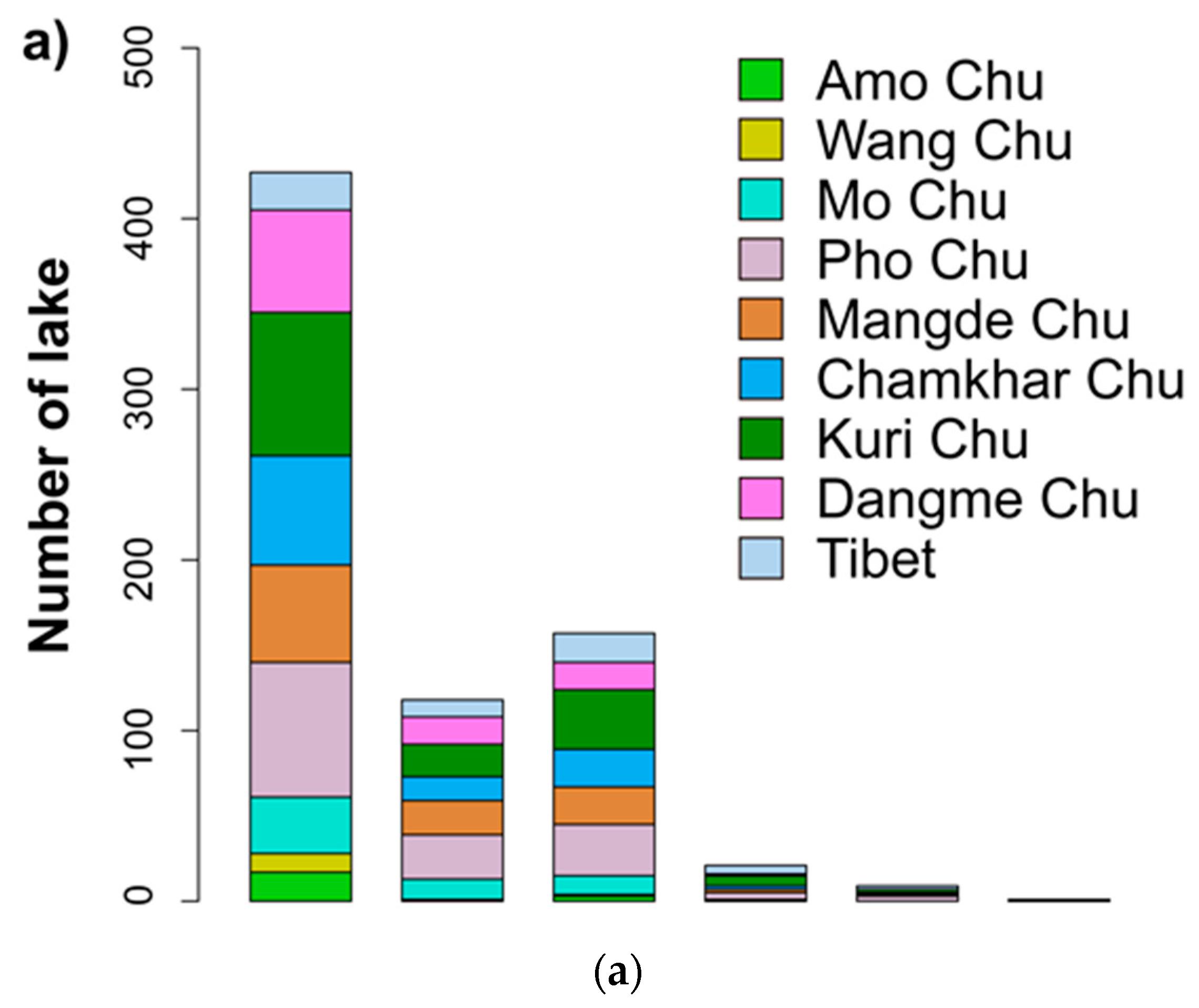
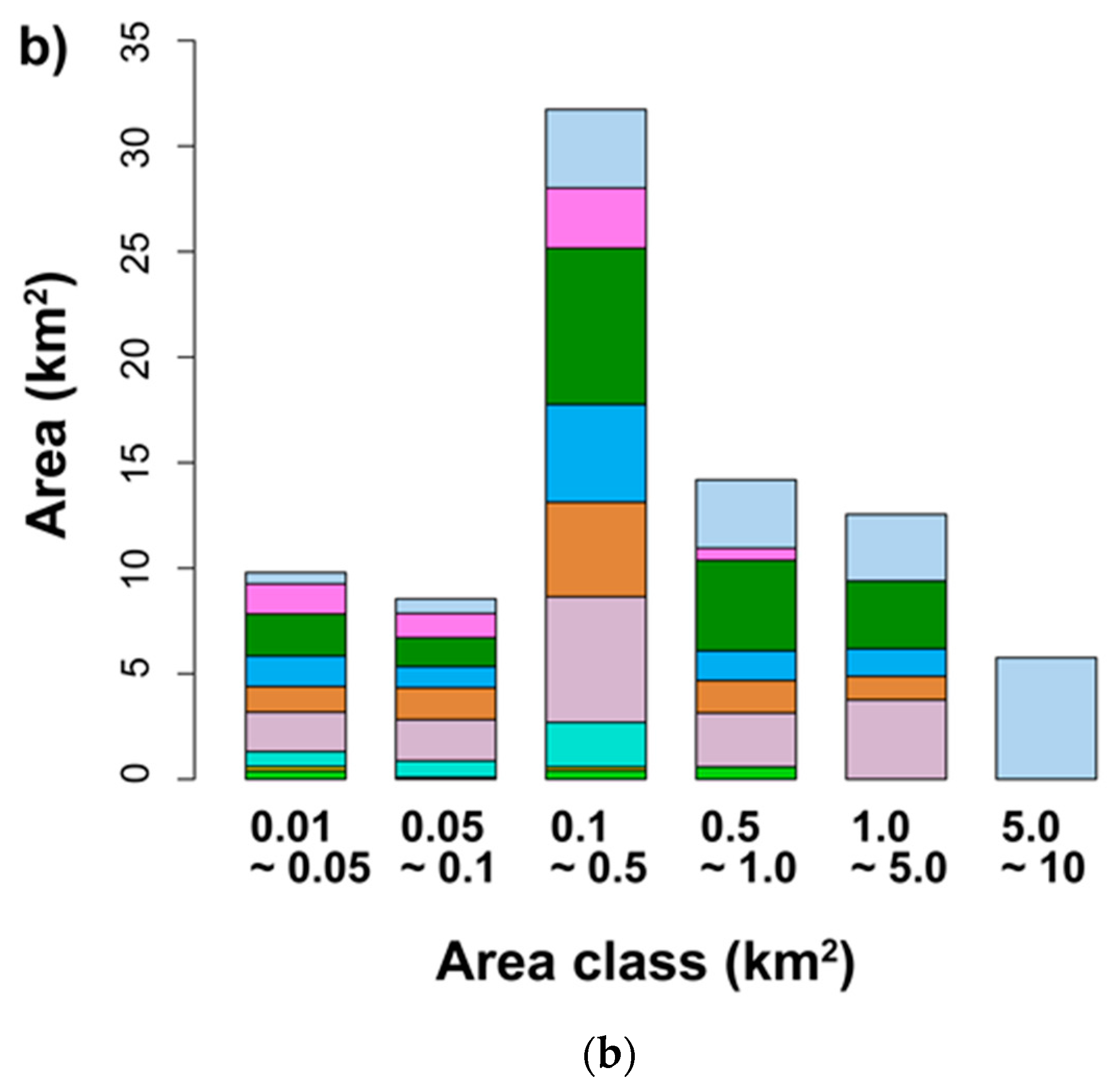
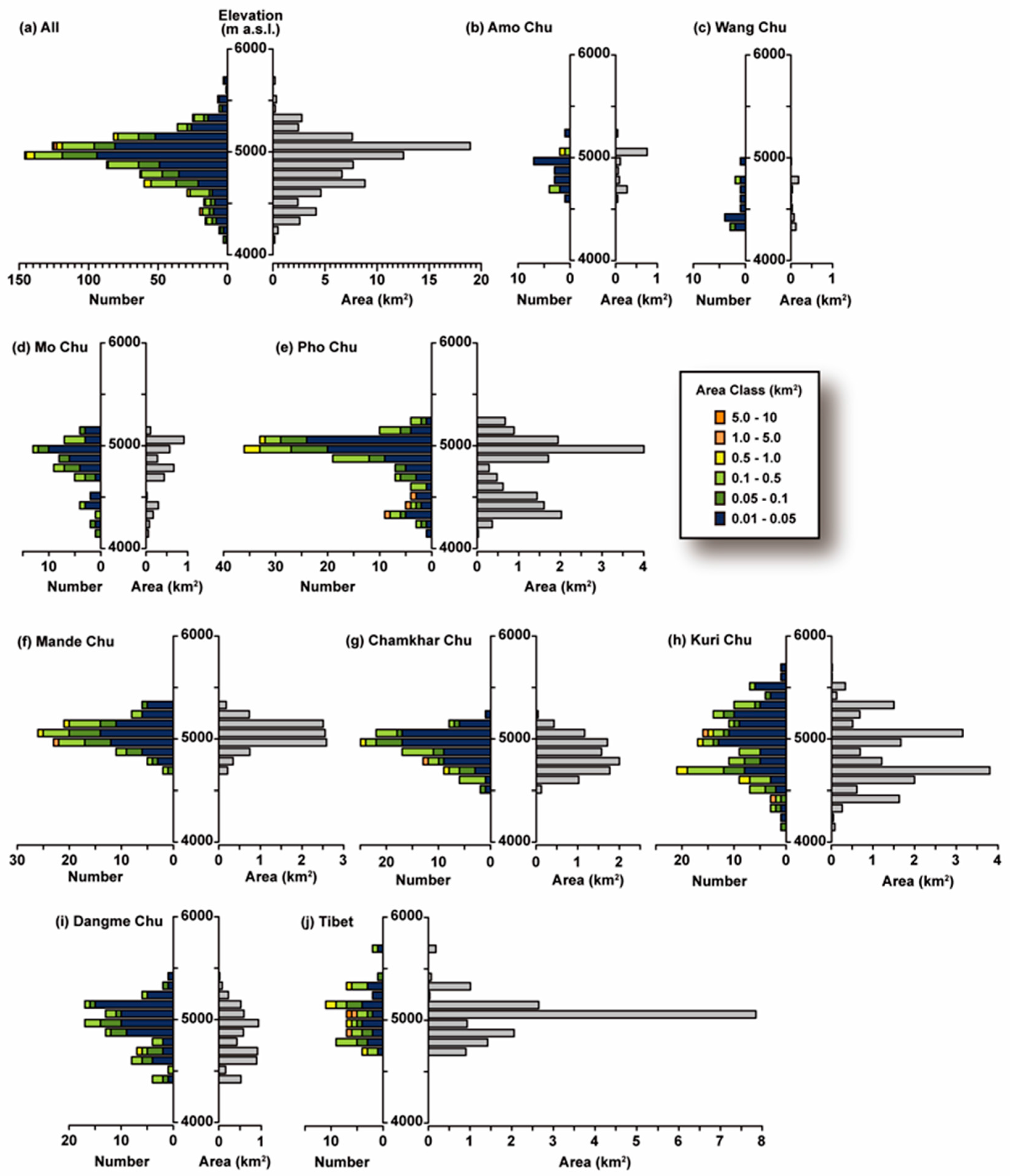
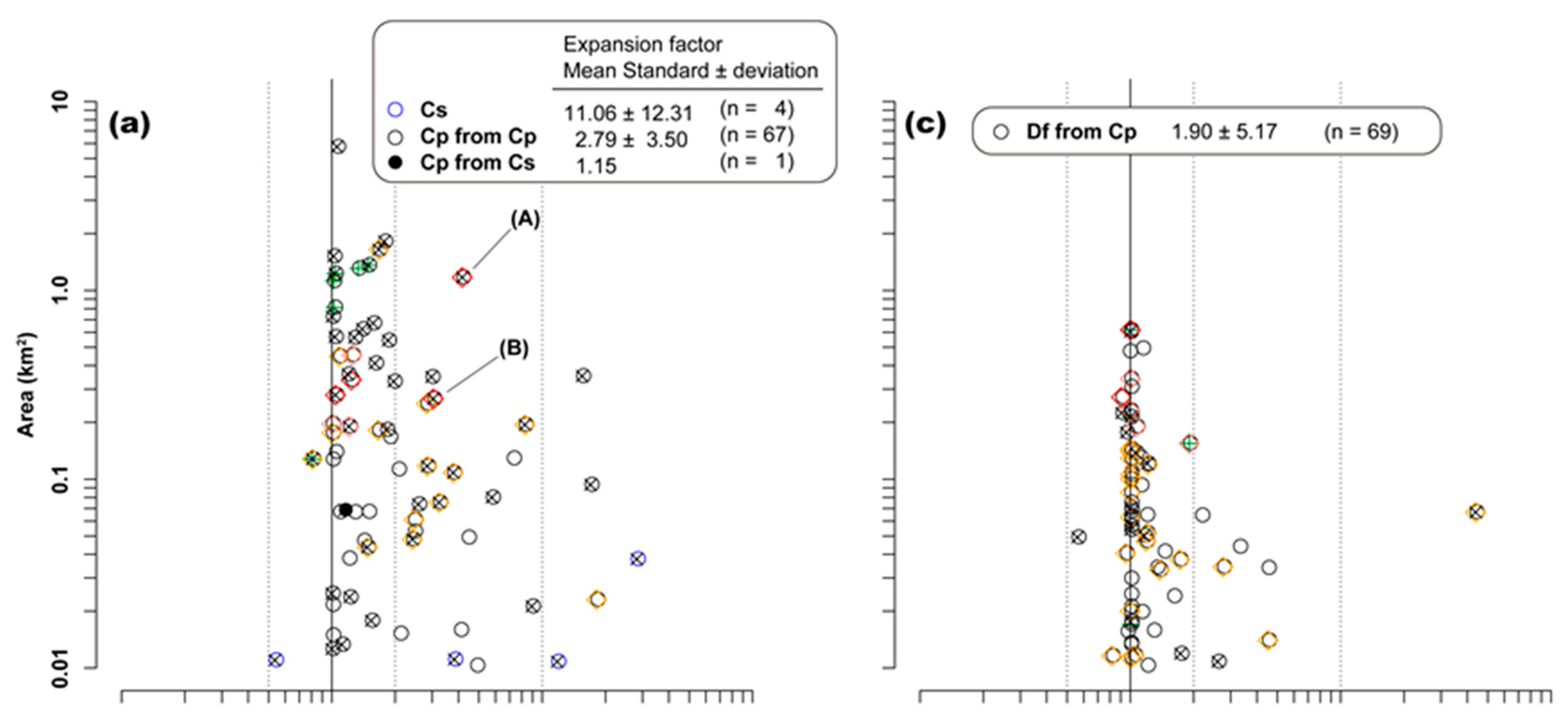


| Satellite | Sensor | Date | Spatial Resolution (m) | Imagery Type | Scene ID |
|---|---|---|---|---|---|
| SPOT-1 | HRV | 01-15-1990 | 10 | Panchromatic | 1 232-294 90-01-15 04:52:22 2 P |
| 01-15-1990 | 1 232-295 90-01-15 04:52:30 2 P | ||||
| 20-12-1989 | 1 233-293 89-12-20 04:52:16 1 P | ||||
| 20-12-1989 | 1 233-294 89-12-20 04:52:25 1 P | ||||
| 20-12-1989 | 1 234-293 89-12-20 04:52:14 2 P | ||||
| 20-12-1989 | 1 234-294 89-12-20 04:52:23 2 P | ||||
| 10-12-1989 | 1 235-294 89-12-10 04:44:35 1 P | ||||
| 10-12-1989 | 1 235-295 89-12-10 04:44:44 1 P | ||||
| 10-12-1989 | 1 236-294 89-12-10 04:44:34 2 P | ||||
| 10-12-1989 | 1 236-295 89-12-10 04:44:42 2 P | ||||
| 04-01-1987 | 1 237-294 87-01-04 04:40:23 1 P | ||||
| 04-01-1987 | 1 237-295 87-01-04 04:40:31 1 P | ||||
| 22-01-1989 | 1 238-295 89-01-22 04:36:28 2 P |
| All | Amo Chu | Wang Chu | Mo Chu | Pho Chu | Mande Chu | Chamkhar Chu | Kuri Chu | Dangme Chu | Tibet | ||
|---|---|---|---|---|---|---|---|---|---|---|---|
| Number | 733 | 21 | 13 | 56 | 142 | 102 | 103 | 146 | 93 | 57 | |
| Basin area (km2) | 6156 | 4954 | 2372 | 2333 | 3820 | 3168 | 9669 | 10,478 | >90,000 | ||
| Areal Density (lakes per km2) | 3.4 × 10−3 | 2.6 × 10−3 | 2.4 × 10−2 | 6.1 × 10−2 | 2.7 × 10−2 | 3.3 × 10−2 | 1.5 × 10−2 | 8.9 × 10−3 | <6.3 × 10−4 | ||
| Elevation (m) | Mean | 5008 | 4953 | 4571 | 4878 | 4941 | 5135 | 4989 | 5033 | 5025 | 5137 |
| Standard deviation | 275.5 | 166.1 | 211.7 | 269.3 | 279.5 | 157.9 | 177.1 | 347.8 | 251.8 | 250.4 | |
| Range | 1751 | 710 | 684 | 1131 | 1233 | 708 | 806 | 1700 | 1126 | 1158 | |
| Maximum | 5885 | 5320 | 5016 | 5292 | 5367 | 5498 | 5374 | 5867 | 5548 | 5885 | |
| 3rd quartile | 5173 | 5064 | 4720 | 5040 | 5131 | 5246 | 5120 | 5301 | 5206 | 5278 | |
| Median | 5037 | 4954 | 4493 | 4940 | 5034 | 5140 | 5014 | 5036 | 5078 | 5124 | |
| 1st quartile | 4853 | 4871 | 4406 | 4787 | 4828 | 5031 | 4859 | 4764 | 4860 | 4916 | |
| Minimum | 4134 | 4610 | 4332 | 4161 | 4134 | 4790 | 4568 | 4167 | 4422 | 4727 | |
| Skewness | −0.43 | −0.05 | 0.73 | −1.02 | −1.10 | −0.03 | −0.42 | 0.00 | −0.53 | 0.74 | |
| Kurtosis | 3.64 | 2.57 | 2.10 | 3.23 | 3.24 | 2.60 | 2.53 | 2.42 | 2.58 | 3.45 |
| ALOS (2006–2011) | Total | |||||||
|---|---|---|---|---|---|---|---|---|
| Cs | Cp | Df | Dn | No Lake | N/A | |||
| SPOT-1 (1987–1990) | Cs | 4 | 1 | 0 | 0 | 0 | 0 | 5 |
| Cp | 0 | 67 | 69 | 0 | 0 | 0 | 136 | |
| Df | 0 | 0 | 403 | 9 | 0 | 0 | 412 | |
| Dn | 0 | 0 | 0 | 43 | 0 | 0 | 43 | |
| No lake | 10 | 29 | 27 | 0 | 0 | 0 | 66 | |
| N/A | 0 | 3 | 17 | 6 | 0 | 45 | 71 | |
| Total | 14 | 100 | 516 | 58 | 0 | 45 | 733 | |
| PFV | Expansion Factor | Lake Area (km2) | ID | ICIMOD | Connectivity | Moraine-/Bedrock-Dammed | Debris-Cover | Glacier | Debris-Covered | Location in Figure 2b | ||||||
|---|---|---|---|---|---|---|---|---|---|---|---|---|---|---|---|---|
| (Million m3) | (1990–2010) | ALOS | SPOT-1 | PDGL | ALOS | SPOT-1 | ID | Area (km2) | Area (km2) | Ratio (%) | ||||||
| (a) PFV >5 m3 | 1 | 33.7 | 1.0 | 0.64 | 0.64 | Ph-016 | ○ | Df | Df | M | 90312 | 2.2 | 0.0 | 0 | ||
| 2 | 30.5 | 4.2 | 1.17 | 0.28 | Ph-051 | Cp | Cp | M | ○ | 90547 | 13.1 | 3.1 | 24 | (A) | ||
| 3 | 27.7 | 1.0 | 0.62 | 0.62 | Ch-019 | ○ | Df | Cp | M | 90805 | 0.5 | 0.0 | 0 | |||
| 4 | 18.6 | 1.0 | 0.58 | 0.59 | Am-018 | Df | Df | M | ○ | 90018 | 2.3 | 0.3 | 12 | |||
| 5 | 17.6 | 1.0 | 0.39 | 0.39 | Ku-133 | Df | Df | M | 91244 | 0.1 | 0.0 | 0 | ||||
| 6 | 16.1 | 3.0 | 0.27 | 0.09 | Da-021 | Cp | Cp | M | ○ | 91459 | 3.2 | 0.6 | 20 | (B) | ||
| 7 | 15.7 | 1.0 | 0.32 | 0.32 | Ku-019 | Df | Df | M | 91115 | 0.1 | 0.0 | 0 | ||||
| 8 | 13.6 | 1.0 | 0.28 | 0.28 | Ku-047 | Df | Df | M | 90982 | 1.3 | 0.0 | 0 | ||||
| 9 | 12.3 | 1.2 | 0.34 | 0.27 | Ti-029 | Cp | Cp | M | 90157 | 1.5 | 0.0 | 0 | ||||
| 10 | 12.1 | 1.0 | 0.28 | 0.27 | Ku-078 | Cp | Cp | M | ○ | 90947 | 1.5 | 0.2 | 12 | |||
| 11 | 10.7 | 0.9 | 0.27 | 0.30 | Ku-039 | Df | Cp | M | 90879 | 2.9 | 0.0 | 0 | ||||
| 12 | 10.7 | 1.0 | 0.27 | 0.27 | Da-001 | Dn | Dn | B | N/A | - | - | - | ||||
| 13 | 8.9 | 1.1 | 0.23 | 0.21 | Mo-030 | ○ | Df | Df | M | ○ | 90261 | 7.9 | 0.1 | 2 | ||
| 14 | 8.7 | - | 0.32 | Before formation | Ma-016 | Cp | - | M | 90588 | 2.1 | 0.0 | 0 | ||||
| 15 | 8.3 | 1.0 | 0.24 | 0.24 | Ma-049 | ○ | Df | Df | M | 90602 | 0.7 | 0.0 | 0 | |||
| 16 | 8.1 | 1.0 | 0.22 | 0.22 | Ku-024 | Df | Df | B | ○ | 91102 | 2.3 | 0.1 | 5 | |||
| 17 | 7.8 | 1.0 | 0.21 | 0.20 | Ti-019 | Df | Df | M | 90103 | 1.8 | 0.0 | 0 | ||||
| 18 | 7.6 | 1.0 | 0.23 | 0.23 | Ti-033 | Df | Cp | M | 90173 | 0.4 | 0.0 | 0 | ||||
| 19 | 7.5 | 1.1 | 0.40 | 0.36 | Ti-005 | Df | Df | M | ○ | 90032 | 1.1 | 0.1 | 10 | |||
| 20 | 7.2 | 1.0 | 0.20 | 0.20 | Da-040 | Cp | Cp | M | 91521 | 1.1 | 0.0 | 0 | ||||
| 21 | 6.9 | N/A | 0.19 | N/A | Ku-095 | Df | N/A | M | 91134 | 2.3 | 0.0 | 0 | ||||
| 22 | 6.7 | 1.0 | 0.36 | 0.36 | Mo-048 | Df | Df | B | 90303 | 0.6 | 0.0 | 0 | ||||
| 23 | 6.6 | 1.0 | 0.13 | 0.13 | Ph-017 | Df | Df | B | 90332 | 0.6 | 0.0 | 0 | ||||
| 24 | 6.4 | 1.0 | 0.19 | 0.19 | Ma-081 | Df | Df | M | 90685 | 0.3 | 0.0 | 0 | ||||
| 25 | 6.2 | 1.3 | 0.17 | 0.13 | Wa-012 | Df | Df | B | 90071 | 0.2 | 0.0 | 0 | ||||
| 26 | 5.8 | 1.1 | 0.13 | 0.13 | Ti-009 | Df | Df | M | ○ | 90040 | 0.8 | 0.0 | 5 | |||
| 27 | 5.8 | 1.2 | 0.19 | 0.16 | Ku-085 | Cp | Cp | M | ○ | 90752 | 2.2 | 0.2 | 10 | |||
| 28 | 5.6 | 1.2 | 0.45 | 0.37 | Ma-061 | Cp | Cp | M | 90639 | 2.1 | 0.0 | 0 | ||||
| 29 | 5.5 | 1.1 | 0.19 | 0.18 | Ti-027 | Df | Cp | M | 90144 | 2.6 | 0.0 | 0 | ||||
| 30 | 5.4 | 0.9 | 0.15 | 0.16 | Ma-059 | Df | Df | M | 90641 | 0.4 | 0.0 | 0 | ||||
| 31 | 5.3 | 1.0 | 0.34 | 0.34 | Ch-101 | Df | Cp | B | 91057 | 2.9 | 0.0 | 0 | ||||
| 32 | 5.2 | 1.9 | 0.15 | 0.08 | Mo-031 | ○ | Df | Cp | M | 90243 | 0.4 | 0.0 | 0 | |||
| 33 | 5.1 | 1.0 | 0.16 | 0.16 | Ch-087 | Df | Df | M | 91024 | 1.0 | 0.0 | 0 | ||||
| (b) PDGL by ICIMOD | 34 | 2.7 | 1.0 | 0.44 | 0.43 | Ph-027 | ○ | Df | Df | M | ○ | 90311 | 12.0 | 2.6 | 21 | |
| 35 | 2.6 | 0.8 | 0.13 | 0.16 | Ph-058 | ○ | Cp | Cp | M | ○ | 90650 | 4.6 | 1.3 | 27 | ||
| 36 | 1.6 | 3.5 | 0.06 | 0.02 | Mo-015 | ○ | Df | Df | M | ○ | 90153 | 1.5 | 0.5 | 32 | ||
| 37 | 1.3 | 1.0 | 0.05 | 0.05 | Mo-014 | ○ | Df | Df | M | ○ | 90140 | 3.5 | 0.8 | 23 | ||
| 38 | 1.2 | 1.1 | 0.19 | 0.18 | Ch-027 | ○ | Df | Df | M | 90773 | 0.9 | 0.0 | 0 | |||
| 39 | 0.8 | 0.9 | 0.03 | 0.03 | Mo-016 | ○ | Df | Df | M | ○ | 90164 | 2.9 | 1.1 | 40 | ||
| 40 | 0.0 | 1.5 | 1.36 | 0.92 | Ph-057 | ○ | Cp | Cp | M | ○ | 90600 | 10.9 | 1.7 | 15 | ||
| 41 | 0.0 | 1.0 | 1.23 | 1.19 | Ph-050 | ○ | Cp | Cp | M | ○ | 90505 | 3.6 | 1.2 | 33 | ||
| 42 | 0.0 | 1.1 | 0.21 | 0.19 | Ph-081 | ○ | Df | Df | M | 90440 | 1.2 | 0.0 | 0 | |||
| 43 | 0.0 | 1.2 | 0.25 | 0.21 | Ph-025 | ○ | Df | Df | M | ○ | 90271 | 3.0 | 0.4 | 15 | ||
| 44 | 0.0 | 1.0 | 0.71 | 0.71 | Ph-008 | ○ | Df | Df | B | 90330 | 0.1 | 0.0 | 0 | |||
| 45 | 0.0 | 1.0 | 0.21 | 0.21 | Ma-008 | ○ | Df | Cp | M | ○ | 90559 | 0.7 | 0.0 | 6 | ||
| 46 | 0.0 | 1.0 | 0.21 | 0.21 | Ma-069 | ○ | Df | Df | M | 90688 | 1.1 | 0.0 | 0 | |||
| 47 | 0.0 | 1.0 | 1.12 | 1.11 | Ma-012 | ○ | Cp | Cp | M | 90576 | 3.8 | 0.0 | 0 | |||
| 48 | 0.0 | 1.0 | 0.81 | 0.79 | Ma-062 | ○ | Cp | Cp | M | 90661 | 3.5 | 0.0 | 0 | |||
| 49 | 0.0 | 1.0 | 0.35 | 0.36 | Ma-057 | ○ | Df | Df | M | 90623 | 1.1 | 0.0 | 0 | |||
| 50 | 0.0 | 1.3 | 1.31 | 0.98 | Ch-074 | ○ | Cp | Cp | M | 90810 | 0.3 | 0.0 | 0 | |||
| 51 | N/A | 1.0 | 0.17 | 0.17 | Ku-129 | ○ | Df | Df | B | 91256 | 0.1 | 0.0 | 0 | |||
| 52 | N/A | 1.0 | 0.02 | 0.02 | Ma-086 | ○ | Df | Cp | M | 90705 | 0.5 | 0.0 | 0 | |||
© 2017 by the authors. Licensee MDPI, Basel, Switzerland. This article is an open access article distributed under the terms and conditions of the Creative Commons Attribution (CC BY) license (http://creativecommons.org/licenses/by/4.0/).
Share and Cite
Nagai, H.; Ukita, J.; Narama, C.; Fujita, K.; Sakai, A.; Tadono, T.; Yamanokuchi, T.; Tomiyama, N. Evaluating the Scale and Potential of GLOF in the Bhutan Himalayas Using a Satellite-Based Integral Glacier–Glacial Lake Inventory. Geosciences 2017, 7, 77. https://doi.org/10.3390/geosciences7030077
Nagai H, Ukita J, Narama C, Fujita K, Sakai A, Tadono T, Yamanokuchi T, Tomiyama N. Evaluating the Scale and Potential of GLOF in the Bhutan Himalayas Using a Satellite-Based Integral Glacier–Glacial Lake Inventory. Geosciences. 2017; 7(3):77. https://doi.org/10.3390/geosciences7030077
Chicago/Turabian StyleNagai, Hiroto, Jinro Ukita, Chiyuki Narama, Koji Fujita, Akiko Sakai, Takeo Tadono, Tsutomu Yamanokuchi, and Nobuhiro Tomiyama. 2017. "Evaluating the Scale and Potential of GLOF in the Bhutan Himalayas Using a Satellite-Based Integral Glacier–Glacial Lake Inventory" Geosciences 7, no. 3: 77. https://doi.org/10.3390/geosciences7030077






